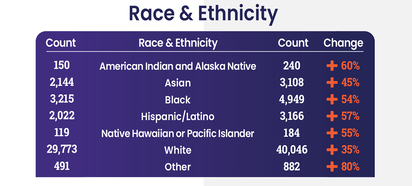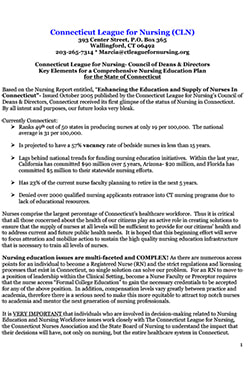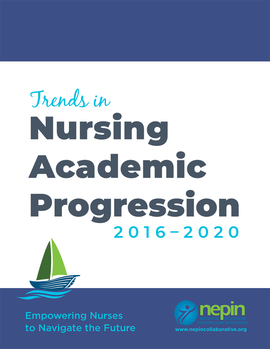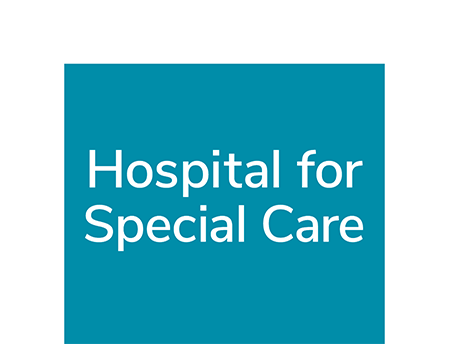Data Reports.Insights into Connecticut Nursing and Healthcare Workforce
|
Lisa Sundean, PhD, MHA, RN
|
Connecticut Nursing Education Reports
- 2021 CT Nursing Education Report- Demographics, Statistics and Recommendations
- 2018 Nursing Education Data
- 2017 Nursing Education Data- Pipeline to Practice in CT
- 2016 Nursing Education Data- Pre-Licensure RN Programs in CT
- CLN Fosters Access to Nursing National Minimum Datasets to Accurately Compare Data
- 2015 Nursing Education Data - Pre-Licensure RN Programs in CT
- 2015 Nursing Education Data - Pre-Licensure LPN Programs in CT
DID YOU KNOW?
|
Supply of Registered Nurses in Connecticut
Data Source: Connecticut Nurse Licensure Program, 2020 and 2022. Published in September 2023. |
|
Number of Working Nurses does NOT Correlate with the Number of Nurses Working in a Nursing Capacity:
|
Connecticut Nursing Workforce Supply Reports
Nursing Workforce Data Trends and Connecticut Recommendations
Registered nurses (RNs) are critical to a functioning healthcare system. Evidence is mounting that recruitment and retention of bedside nursing staff in acute care hospitals is a challenge of increasing magnitude. Connecticut faces significant obstacles in ensuring an adequate number of highly skilled bedside nurses in an era of aging and medically complex patients.
Below are two reports sharing the challenges and recommendations for solutions to produce a robust and sustainable nursing workforce in CT!
Below are two reports sharing the challenges and recommendations for solutions to produce a robust and sustainable nursing workforce in CT!
Connecticut Nursing Faculty ShortageBarriers experienced by Academic Institutions to increase student enrollment.
|
Connecticut Nursing Education & Supply
|
2005 Enhancing the Education and Supply of Nurses in Connecticut: Report and Recommendations are intended to provide information and a direction for action that will help assure that Connecticut will have a sufficient number of well-educated nurses to meet the healthcare needs of our citizens. The Deans and Directors of nursing programs in Connecticut are in a unique position to access the capacity and resources for nursing education and participate with other stakeholders in determining the workforce size and composition that is required for the future.
|
DID YOU KNOW?
Supply of Licensed Practical Nurses in Connecticut
Data Source: Connecticut Nurse Licensure Program, 2020 and 2022. Published in September 2023
Number of Working LPNs does NOT Correlate with the Number of LPNs Working in a Nursing Capacity:
- In 2020, CT had 7,130 LPNs actively working, but only 6,113 were working in a nursing capacity. 86 % of LPNs were working in a nursing capacity.
- In 2022, CT had 9,990 LPNs actively working, but only 8,343 were working in a nursing capacity. 84 % of LPNs were working in a nursing capacity
Comprehensive Nursing Education Recommendations
|
CLN's 2005 Key Elements for a Comprehensive Nursing Education Plan for the State of Connecticut
Nurses comprise the largest percentage of Connecticut's healthcare workforce. Thus it is critical that all those concerned about the health of our citizens play an active role in creating solutions to ensure that the supply of nurses at all levels will be sufficient to provide for our citizens' health and to address current and future public health needs. |
National Nursing Reports.
Nursing Academic ProgressionTrends in Nursing Academic Progression 2016-2020
NEPIN, the National Education Progression in Nursing collaborative, sought to locate and evaluate a single data source to equitably interpret current trends in academic progression. Created as an expansion of the former Academic Progression in Nursing (APIN) initiative of the Robert Woods Johnson Foundation, NEPIN is the only national entity solely devoted to ensuring that nurses have access to higher levels of education and achievement. Operating under the fiscal oversight of the OADN Foundation (a federally recognized 501c3 nonprofit organization), NEPIN’s stakeholders understand that successful patient outcomes depend on a well-equipped and sufficiently supported nursing workforce. |
The Future of NursingThe Future of Nursing: Leading Change, Advancing Health
This report is being published at a time of great opportunity in health care. Legislation passed in March 2010 will provide access to health care for 32 million more Americans. The implications of this new demand on the nation's health care system are significant. This report begins with the assumption that nursing can fill new and expanded roles in a redesigned health care system. To take advantage of these opportunities, however, nurses must be allowed to practice in accordance with their professional training, and the education they receive must better prepare them to deliver patient-centered, equitable, safe, high-quality health care services, engage with physicians and other health care professionals to deliver efficient and effective care. |
|




















































